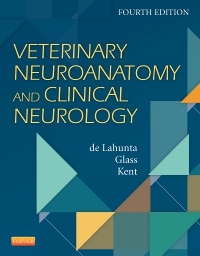
Veterinary Neuroanatomy and Clinical Neurology - Elsevier eBook on VitalSource, 4th Edition
Elsevier eBook on VitalSource

Covering the anatomy, physiology, and pathology of the nervous system, Veterinary Neuroanatomy and Clinical Neurology, 4th Edition helps students learn to diagnose the location of neurologic lesions in small animals, horses, and food animals. Practical guidelines show how to perform neurologic examinations, interpret examination results, and formulate effective treatment plans. Descriptions of neurologic disorders are accompanied by clinical case examples and illustrations, radiographs, and online video clips. A new chapter on Uncontrolled Involuntary Skeletal Muscle Contractions expands on the explanation of this important movement disorder, making this edition an essential tool in accurately diagnosing and treating neurologic disorders!
Newer Edition Available
de Lahunta’s Veterinary Neuroanatomy and Clinical Neurology - Elsevier eBook on VitalSource
-
- NEW! High-quality, state-of-the-art MR images in the Neuroanatomy by Dissection chapter takes an atlas approach to presenting normal brain anatomy of the dog, filling a critical gap in the literature since Marcus Singer’s The Brain of the Dog in Section
- NEW Uncontrolled Involuntary Skeletal Muscle Contractions chapter provides new coverage of this movement disorder.
- More than 250 high-quality radiographs and 800 vibrant color photographs and line drawings depict anatomy, physiology, and pathology (including gross and microscopic lesions), and enhance students’ ability to diagnose challenging neurologic cases.
- NEW case examples link to corresponding videos of the actual patient described, providing students with additional practice working their way through real-life scenarios to reach an accurate diagnosis and an effective treatment plan for neurologic disorders.
- A companion website hosted by Cornell University College of Veterinary Medicine features more than 380 videos that bring concepts to life and clearly demonstrate the neurologic disorders and examination techniques described in case examples throughout the text.
- Disease content is presented as case descriptions, allowing students to learn in a manner that is similar to the challenge of diagnosing and treating neurologic disorders in the clinical setting: 1) Description of the neurologic disorder, 2) Neuroanatomic diagnosis and how it was determined, the differential diagnosis, and any ancillary data, and 3) Course of the disease, the final clinical or necropsy diagnosis, and a brief discussion of the syndrome.
- NEW! A detailed Video Table of Contents in the front of the book makes it easier to access the videos that correlate to case examples.
- High-quality MR images correlate with stained transverse sections of the brain, showing minute detail that the naked eye cannot see.
-
- NEW! High-quality, state-of-the-art MR images in the Neuroanatomy by Dissection chapter takes an atlas approach to presenting normal brain anatomy of the dog, filling a critical gap in the literature since Marcus Singer’s The Brain of the Dog in Section.
- NEW Uncontrolled Involuntary Skeletal Muscle Contractions chapter provides new coverage of this movement disorder.
- NEW case descriptions offer additional practice in working your way through real-life scenarios to reach an accurate diagnosis and an effective treatment plan for neurologic disorders.
- NEW! A detailed Video Table of Contents in the front of the book makes it easier to access the videos that correlate to case examples.
-
1. Introduction
2. Neuroanatomy by Dissection
3. Development of the Nervous System: Malformation
4. Cerebrospinal Fluid and Hydrocephalus
5. Lower Motor Neuron: Spinal Nerve, General Somatic Efferent System
6. Lower Motor Neuron: General Somatic Efferent, Cranial Nerve
7. Lower Motor Neuron: General Visceral Efferent System
8. Upper Motor Neuron
9. General Sensory Systems: General Proprioception and General Somatic Afferent
10. Small Animal Spinal Cord Disease
11. Large Animal Spinal Cord Disease
12. Vestibular System: Special Proprioception
13. Cerebellum
14. Visual System
15. Auditory System: Special Somatic Afferent System
16. Visceral Afferent Systems
17. Nonolfactory Rhinencephalon: Limbic System
18. Seizure Disorders: Narcolepsy
19. Diencephalon
20. Uncontrolled Involuntary Skeletal Muscle Contractions NEW!
21. The Neurologic Examination
22. Case Descriptions


 as described in our
as described in our 